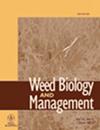Effect of management practices for Stylosanthes hamata (L.) Taub. biomass cover on the weed species in different direct-seeding, mulch-based cropping systems
IF 1.5
4区 农林科学
Q3 AGRONOMY
引用次数: 1
Abstract
Weed management is a major challenge for smallholders’ adoption of conservation agriculture techniques. The phytological composition and weed biomass in five direct‐seeding cropping systems based on the millet–groundnut rotation, with permanent cover provided by Stylosanthes hamata (L.) Taub., were evaluated after 3 years in western Senegal. A transect was used to determine the phytological composition. The weed biomass was measured in five quadrats in the middle and at the end of the plant growth cycle. This study shows that S. hamata ground cover does not allow the effective control of weeds; high weed infestation was recorded in all direct‐seeding cropping systems (58–75% of the ground cover). A high diversity of weed species was observed in all treatments, dominated by Eragrostis ssp. and Dactyloctenium aegyptium Beauv. Cutting back and removing the aboveground biomass reduced the ground cover provided by S. hamata, lowered the weed species diversity and favored heliophilous species such as Eragrostis tremula but did not reduce weed infestation. Animal manure application did not, in the short term, affect the composition or structure of the weed species. However, it favored weed development and increased aboveground biomass. In the long term, this could affect weed seedbank and structure. Cutting back and removing the aboveground biomass of S. hamata resulted in lower weed diversity and higher crop yield. To achieve effective weed control, additional research on management techniques that would focus on the combination of cutting back vegetation and weeding along the crop seeding line will be needed.管理措施对滨花柱花草生长的影响陶布。不同直播、覆膜种植制度下杂草的生物量覆盖
杂草管理是小农户采用保护性农业技术的一大挑战。以小米-花生轮作为基础,由柱花草(Stylosathes hamata(L.)Taub提供永久覆盖的五个直播种植系统的植物组成和杂草生物量。,在塞内加尔西部3年后进行了评估。用样带测定植物组成。在植物生长周期中期和末期的五个象限中测量杂草生物量。这项研究表明,滨水藻地面覆盖物不能有效控制杂草;所有直播种植系统的杂草侵扰率都很高(占地面覆盖率的58%-75%)。在所有处理中都观察到杂草物种的高度多样性,以Eragrostis ssp为主。和埃及Dactyloctenium aegyptium Beauv。削减和移除地上生物量减少了滨水藻提供的地面覆盖,降低了杂草物种多样性,有利于喜日光性物种,如特雷木虱,但没有减少杂草侵扰。短期内,施用动物粪便不会影响杂草的组成或结构。然而,它有利于杂草的生长和地上生物量的增加。从长远来看,这可能会影响杂草的种子库和结构。减少和去除滨水藻地上生物量可降低杂草多样性,提高作物产量。为了实现有效的杂草控制,需要对管理技术进行更多的研究,重点是修剪植被和沿着作物播种线除草。
本文章由计算机程序翻译,如有差异,请以英文原文为准。
求助全文
约1分钟内获得全文
求助全文
来源期刊

Weed Biology and Management
农林科学-农艺学
CiteScore
2.70
自引率
0.00%
发文量
13
审稿时长
>36 weeks
期刊介绍:
Weed Biology and Management is an international journal, published four times per year. The journal accepts contributions in the form of original research and review articles in all aspects of weed science. Contributions from weed scientists in the Asia–Pacific region are particularly welcomed.
The content of the contributions may relate to weed taxonomy, ecology and physiology, weed management and control methodologies, herbicide behaviors in plants, soils and environment, utilization of weeds and other aspects of weed science. All contributions must be of sufficient quality to extend our knowledge in weed science.
 求助内容:
求助内容: 应助结果提醒方式:
应助结果提醒方式:


